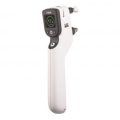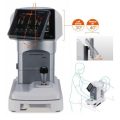-
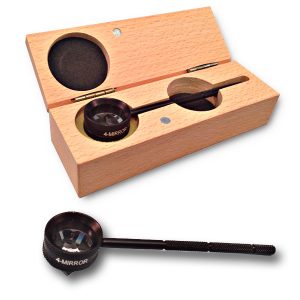 This 4 mirror glass lens is used for viewing all quadrants of the anterior chamber without lens repositioning. Mirrors are placed at angles of 62 degrees. No flange. No fluid required. Removable handle screws into place. Lens diameter: 20mm Rim Diameter: 25mm Lens Contact Point: 9mm Comes with padded case Item #: AMPDSG
This 4 mirror glass lens is used for viewing all quadrants of the anterior chamber without lens repositioning. Mirrors are placed at angles of 62 degrees. No flange. No fluid required. Removable handle screws into place. Lens diameter: 20mm Rim Diameter: 25mm Lens Contact Point: 9mm Comes with padded case Item #: AMPDSG -
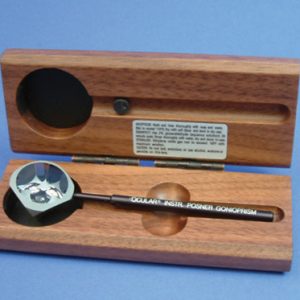
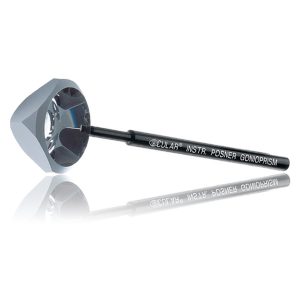 Ideal for use with children or patients with a small palpebral fissure. The instrument consists of a highly polished truncated silver surfaced pyramid with a plane anteroir viewing surface over four mirrors. An aluminum handle set at 35 degrees is bonded to one corner of the lens. The lens is used in the diamond position (45 degrees) resulting in fewer adjustments of lowering and elevating the slit beam with either hand. Item #: OCIOPDSG
Ideal for use with children or patients with a small palpebral fissure. The instrument consists of a highly polished truncated silver surfaced pyramid with a plane anteroir viewing surface over four mirrors. An aluminum handle set at 35 degrees is bonded to one corner of the lens. The lens is used in the diamond position (45 degrees) resulting in fewer adjustments of lowering and elevating the slit beam with either hand. Item #: OCIOPDSG -
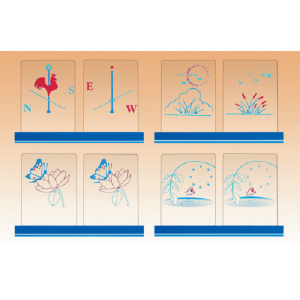 Fusional training 4 card pairs set suitable to develop ocular coordination, by establishing a flexible interaction in accommodative-vergence system through 4 card pair level. Polycarbonate material, sliding track included. Item #: E/FC
Fusional training 4 card pairs set suitable to develop ocular coordination, by establishing a flexible interaction in accommodative-vergence system through 4 card pair level. Polycarbonate material, sliding track included. Item #: E/FC -
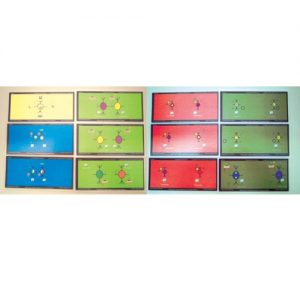 Aperture Rule™ Set (12 Stereoscope sized cards) These cares are more complex and require more detail demand. They build flexibility, resiliency, attention to detail and reduction of visual fatigue. These cards contain large quantities of details and build large ranges of fusion (leading to high amounts of prism diopters of 'Base Out' and 'Base In' fusion ranges) 12 Cards
Aperture Rule™ Set (12 Stereoscope sized cards) These cares are more complex and require more detail demand. They build flexibility, resiliency, attention to detail and reduction of visual fatigue. These cards contain large quantities of details and build large ranges of fusion (leading to high amounts of prism diopters of 'Base Out' and 'Base In' fusion ranges) 12 Cards -
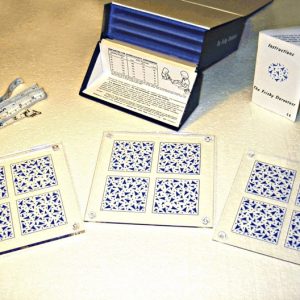 All Frisby Stereo Test Present "real depth" objects viewed with natural vision: no testing glasses are required. Each plate has four random-pattern squares with a circle of pattern elements lying in depth relative to its surround. The depth effect is due to the circle and its surround being printed on opposite sides of the plate. The Frisby Stereo Test has 3 plates allowing for testing stereo acuity disparity as fine as 15 seconds of arc.
All Frisby Stereo Test Present "real depth" objects viewed with natural vision: no testing glasses are required. Each plate has four random-pattern squares with a circle of pattern elements lying in depth relative to its surround. The depth effect is due to the circle and its surround being printed on opposite sides of the plate. The Frisby Stereo Test has 3 plates allowing for testing stereo acuity disparity as fine as 15 seconds of arc. -
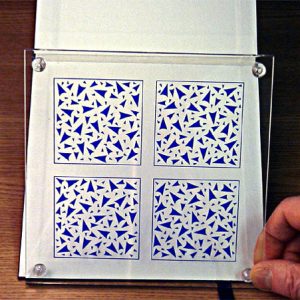 All Frisby Stereo Test Present "real depth" objects viewed with natural vision: not testing glasses are required. Each plate has four random-patten squares, with a circle of pattern elements, lying in depth relative to its surround. The depth effect is due to the circle and its surround being printed on opposite sides of the plate. The purpose of the Frisby Screening Stereo Test - Single Plate, is to demonstrate the presence of stereopsis.
All Frisby Stereo Test Present "real depth" objects viewed with natural vision: not testing glasses are required. Each plate has four random-patten squares, with a circle of pattern elements, lying in depth relative to its surround. The depth effect is due to the circle and its surround being printed on opposite sides of the plate. The purpose of the Frisby Screening Stereo Test - Single Plate, is to demonstrate the presence of stereopsis. -
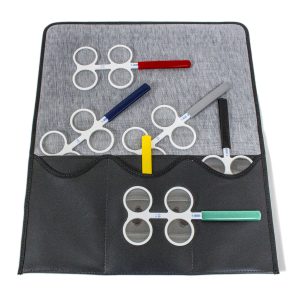 FLIPPER CASE INCLUDED. Professional level six piece set features plus/minus powers in 0.25, 0.50, 1.00, 1.50, 2.00 and 2.50 diopters. Deluxe black carrying case or the economy flipper holder included. Specify which you prefer. Flippers come with colored handle covers. Your account must be registered as a healthcare professional or a school/government in order to purchase this product.Item #: BC1270SET
FLIPPER CASE INCLUDED. Professional level six piece set features plus/minus powers in 0.25, 0.50, 1.00, 1.50, 2.00 and 2.50 diopters. Deluxe black carrying case or the economy flipper holder included. Specify which you prefer. Flippers come with colored handle covers. Your account must be registered as a healthcare professional or a school/government in order to purchase this product.Item #: BC1270SET -
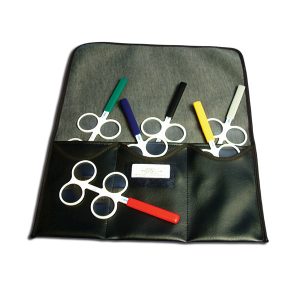 Flippers are used to test and train for accomodative facility, accommadative rock, positive/negative relative accommodation and convergence and fusional convergence reserves. May delay bifocal use with some early presbyopes. Flippers assists in hyperopia screening and lens demonstrations. Help determine dominancy and powers when fitting monovision contacts. Durable white plastic holds shape under low heat for lens insertion. Powers listed on handle. Deluxe Black carrying case or the economy flipper holder included. Item #: BC1270SETSP
Flippers are used to test and train for accomodative facility, accommadative rock, positive/negative relative accommodation and convergence and fusional convergence reserves. May delay bifocal use with some early presbyopes. Flippers assists in hyperopia screening and lens demonstrations. Help determine dominancy and powers when fitting monovision contacts. Durable white plastic holds shape under low heat for lens insertion. Powers listed on handle. Deluxe Black carrying case or the economy flipper holder included. Item #: BC1270SETSP -
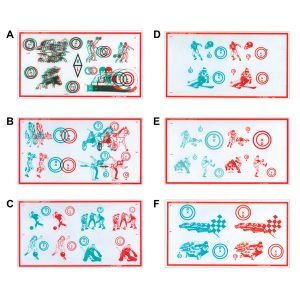 Fixed Demands Tranaglyph™ Kit (50 Series) Ideal for testing or training in true space at the office or home. Eliminates suppression while developing fusion and stereopsis. Non-variable prismatic Red/Green slides build fusional convergence & divergence. 2PD increments from 0 to 30PD BI or BO. 10" x 5.5" Red/Green targets on frosted vinyl. Can be used with Polachrome Trainer.Item #: BC50K+
Fixed Demands Tranaglyph™ Kit (50 Series) Ideal for testing or training in true space at the office or home. Eliminates suppression while developing fusion and stereopsis. Non-variable prismatic Red/Green slides build fusional convergence & divergence. 2PD increments from 0 to 30PD BI or BO. 10" x 5.5" Red/Green targets on frosted vinyl. Can be used with Polachrome Trainer.Item #: BC50K+ -
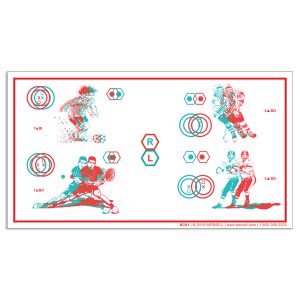
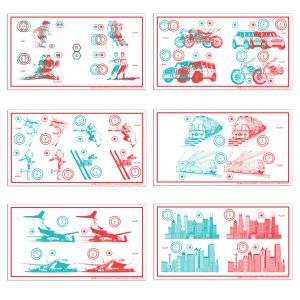 Fixed Demands Tranaglyph™ Kit (60 Series) Ideal for testing or training in true space at the office or home. Eliminates suppression while developing fusion and stereopsis. Non-variable prismatic Red/Green slides build fusional convergence & divergence. 2PD increments from 0 to 30PD BI or BO. 10" x 5.5" Red/Green targets on frosted vinyl. Can be used with Polachrome Trainer. Item #: BC60K+
Fixed Demands Tranaglyph™ Kit (60 Series) Ideal for testing or training in true space at the office or home. Eliminates suppression while developing fusion and stereopsis. Non-variable prismatic Red/Green slides build fusional convergence & divergence. 2PD increments from 0 to 30PD BI or BO. 10" x 5.5" Red/Green targets on frosted vinyl. Can be used with Polachrome Trainer. Item #: BC60K+ -
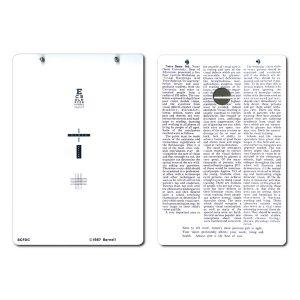 Variable slide adjust to determine fixation disparity or may be used with hand held prisms. Designed for phoroptor use. The card comes with a label which may be placed over the prism diopter scale for an additional scale in degrees. Reverse side of card includes reduced Snellen, fusional target and cross cylinder targets. 5-1/2" x 8" card and polarized goggle. Item #: BCFDC
Variable slide adjust to determine fixation disparity or may be used with hand held prisms. Designed for phoroptor use. The card comes with a label which may be placed over the prism diopter scale for an additional scale in degrees. Reverse side of card includes reduced Snellen, fusional target and cross cylinder targets. 5-1/2" x 8" card and polarized goggle. Item #: BCFDC -
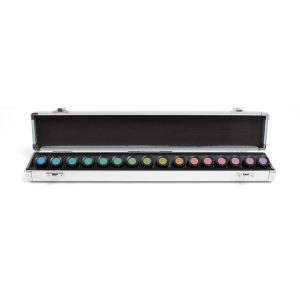 Farnsworth Test for Congenital and Acquired color defects. The Farnsworth D-15 contains a reference disc holding notation 10 B 5 4 and fifteen numbered discs which make up an incomplete color circle. The patient arranges the discs and then evaluation of the patients arrangement separates 'normal' color perception from moderate and strong defects in deutan, protan or tritan axis color discrimination. The disks are spread out on a table and arranged by the patient. The Farnsworth D-15 test is a subset of the well known Farnsworth 100 Hue Test. It is intended for classification instead of in-depth study of color vision defects. The D-15 and 100 hue tests are correlated. Growing Importance of Color deficiency Screening: In addition to congenital color deficiency screening there is growing evidence that adult acquired color deficiency, especially in yellow and blue perception, can indicate medical toxicity and other problems. Increasingly complex security and medical systems also require verification of all three types of color receptors. How the D-15 test works: The Farnsworth D15 is called 'dichotomous' because it is designed to separate subjects into one of two groups, 1) Strongly color deficient or 2) Mildly color deficient or color normal. This is accomplished by the arrangement of vivid (saturated) colored discs. A perfect score shows normal color perception. A non-perfect score is used to determine a medium or strong color deficiency.
Farnsworth Test for Congenital and Acquired color defects. The Farnsworth D-15 contains a reference disc holding notation 10 B 5 4 and fifteen numbered discs which make up an incomplete color circle. The patient arranges the discs and then evaluation of the patients arrangement separates 'normal' color perception from moderate and strong defects in deutan, protan or tritan axis color discrimination. The disks are spread out on a table and arranged by the patient. The Farnsworth D-15 test is a subset of the well known Farnsworth 100 Hue Test. It is intended for classification instead of in-depth study of color vision defects. The D-15 and 100 hue tests are correlated. Growing Importance of Color deficiency Screening: In addition to congenital color deficiency screening there is growing evidence that adult acquired color deficiency, especially in yellow and blue perception, can indicate medical toxicity and other problems. Increasingly complex security and medical systems also require verification of all three types of color receptors. How the D-15 test works: The Farnsworth D15 is called 'dichotomous' because it is designed to separate subjects into one of two groups, 1) Strongly color deficient or 2) Mildly color deficient or color normal. This is accomplished by the arrangement of vivid (saturated) colored discs. A perfect score shows normal color perception. A non-perfect score is used to determine a medium or strong color deficiency.

